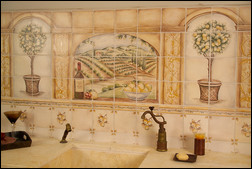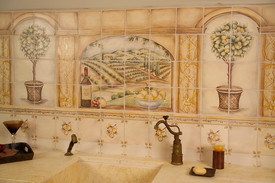The backsplash is the perfect union of form and function in the kitchen. As its name indicates, the backsplash protects the kitchen wall from damage and cooking messes. It also provides an easier surface to clean than drywall. With the right materials and design, the kitchen backsplash can become the focal point of a kitchen or serve to augment the kitchen’s overall aesthetic theme. There are numerous materials to choose from, and design options are limited only by the homeowner’s imagination.
 A hand-painted mural of the Tuscan countryside on fresco tile. Photo courtesy of Charles Tiles, Inc. |
Focal Point or Bit-Part Player
Before selecting a material, design or color, the homeowner needs to step back and consider the big picture. “Think about the whole room,” advises Dana Jones, CKD and founder of The Kitchen Consultant. “Sometimes the backsplash can be the focal point of the room, but a lot of times some other element should be drawing the eye.” The range hood, island or some other fixture within the room might best serve as the attention-grabber. In these scenarios, the homeowner’s kitchen may be better with a more subtle or subdued backsplash display.
On the other hand, a well-conceived backsplash can effectively distract the eye away from potential eyesores, like a window with a terrible view. When considering the backsplash as part of the big picture, Jones considers where homeowners would want the attention drawn. She also considers how the homeowners and guests would most likely enter the kitchen and is careful not to overexcite the senses. “You have to give the eye resting places,” she says. “You have to give it a place to stop.” An expansive tiling job that stretches the length of the wall, incorporates multiple materials and features many diverse elements or colors can threaten to overshadow other attractive aspects of the kitchen design.
Drawing Inspiration
The endless options within each backsplash material category are both blessing and curse to the homeowner. With the sky the limit, choosing a winning combination of material, shape, size and color can be a challenge. To avoid getting lost in the sea of endless possibility, the homeowner should draw on existing elements in the kitchen for inspiration. According to Jessica Horne, floor manager for Charles Tiles, Inc. of Stockton, N.J., homeowners shopping for backsplash materials in the store showroom do so with any number of bits and pieces from their kitchen. “They’ll bring in samples of cabinet doors, the countertop, knobs, big swatches of paint and fabrics, and sometimes even particular plates they are trying to work around,” says Horne.
The more information a homeowner can offer a salesperson or designer, the better the end result. Actual pictures of the kitchen space will also help a salesperson or designer pull out colors and select accents for the backsplash that will complement the kitchen’s artistic theme.
Backsplash Material Options
Choosing a backsplash material is one of the more important decisions to be made. To help narrow down the options, here’s a list of some materials to consider:
Ceramic tile backsplashes remain a very popular choice among consumers. The wide variety of colors, shapes and sizes within the ceramic tile family makes this option a versatile one. It is also low on maintenance needs; unlike stone, a ceramic tile backsplash won’t require regular sealing to prevent staining.
Porcelain is a step up from ceramic. Where ceramic is made from clay, porcelain tiles are made from pressed porcelain dust. Porcelain is harder and more dense than ceramic, making it a more durable option. It is also harder to cut and requires a wet saw.
Stone is a backsplash material family name with more than a few members. Within this larger category there is limestone, slate, marble and granite, among others. The stone backsplash can match a countertop material carrying a consistent color and texture to the wall that can be accented in any number of ways. Stone is also a great material for a mosaic backsplash project. Stone tiles may need to be sealed to prevent staining.
The stainless-steel backsplash is an option for the homeowner looking to match this kitchen feature to appliances of the same material. The stainless-steel backsplash can be fabricated out of sheet metal to display a variety of surface textures. Stainless steel is easy to clean, but scratches can mar a once pristine surface. A stainless-steel backsplash can also be costly, ranging from $20 per square foot up for material alone.
 A kitchen backsplash mosaic by Tile By Design. Photo courtesy of Tile By Design. |
Other metals used as backsplash material include copper, tin, brass and nickel. These options can lend a rustic feel to the kitchen, but they also dent and scratch easily, require polishing to maintain their shine and color unevenly over time due to oxidization. Like stainless steel, these metal backsplashes can be fabricated out of sheet metal or come in tile form to use as accents to a stone or ceramic backsplash. Because metal tiles tend to be expensive, using them as accents is often preferred.
The metal laminate backsplash is an inexpensive alternative to metal. Constructed much like plastic laminate, the product is covered with a metallic layer. Options include aluminum, stainless steel, copper and brass. The surface finish, texture and pattern can vary in a metal laminate. Metal laminate products can be found at Home Depot and Lowe’s, sold in sheets of varying size and often install using two-sided adhesive tape or similar adhesive. Manufacturer’s recommendations on installation should be followed.
Glass is an ideal surface for the kitchen backsplash since it is easy to clean and entirely non-porous. Glass tile can be translucent, iridescent, stained or opaque in appearance. It is a popular choice of material for mosaics and adds a luminescence to the space. Glass tiles can come back-painted and in sheet form or as individual tiles.
The Backsplash Mural, Customized
The tile mural backsplash is not a new concept. Everything from beach scenes and bowls of fruit to classic Monet and Renaissance artwork is available in stone, porcelain and ceramic tile mural form. Once assembled and installed, these upscale additions to the kitchen wall speak to the homeowner’s artistic tastes. Available in a variety of tile and mural sizes, the backsplash mural can stand alone or be surrounded by “field” tile that serves as the framework for the backsplash focal point.
For homeowners looking for a truly custom kitchen backsplash mural or mosaic, companies like Tile By Design let the consumer turn any image, photo or piece or artwork into a tile mural. “We take a photo of original artwork supplied by the customer and put the image on the tiles,” says Lori Stout, co-owner of Tile by Design of Fort Wayne, Ind. According to Stout, the custom backsplash mural trend is growing. “People are looking for more decorative things to put behind their stove,” she says. To have Tile by Design turn a piece of artwork into a tile mural, customers need a high-resolution image (at least 300 dpi) and permission from the artist. The shipped, finished tiles are lettered and numbered on the back for easy assembly and should be installed using a sandless grout to prevent hairline scratches in the finish.
A Backsplash in a Box
Pre-assembled, decorative backsplashes are the latest option in this ever-growing category. Ready to hang out of the box, these framed ceramic or stone tile pieces require no gluing, grouting or sealing. Broan-NuTone’s pre-assembled backsplashes come with anchors, a mounting bracket and a template for easy installation in under 10 minutes. The company’s four unique backsplash designs come in 30” x 14”, 30” x 20” and 36” x 20” sizes to fit most wide range and cooktop areas. Prices range from $260 to $360 depending on size and design.
Consider a Professional Installer
While installing a backsplash is well within the realm of possibility for the DIY-inclined, this might be one project best left for the professional installer. Jim Olson, assistant executive director for the National Tile Contractors Association (NTCA), believes a homeowner should tackle the backsplash job only if he or she feels comfortable with it and all the research has been done. “If you feel the finished product is beyond you, contact a professional,” says Olson. “The backsplash can say more about the kitchen than anything else. You don’t want it looking like a DIY job.”
A professional tile contractor can be contacted to give a free estimate for a kitchen backsplash job. Some contractors may charge by the square foot, but many will charge for the completed job, taking into account cuts and cut-outs, material varieties and estimated time of completion. “Most will carry a minimum charge, but additional charges for murals, inserts and accents should be itemized,” says Olson.
When working with a professional, a homeowner can choose to purchase all the materials first or have the contractor handle that aspect. Choosing the latter can be beneficial as any shortage in material that results in a longer installation time will be the responsibility of the contractor. If a homeowner does not order enough materials and is forced to purchase more, the additional time to completion will mostly likely incur additional charges.
A professional will also bring the necessary tools to the job site, have experience cutting and dealing with obstacles like outlets, and will know how to seamlessly incorporate trim work and corners into the project. “Doing tile is not like putting carpet or sheet metal down,” says Olson.
A professional will also know which grout to use for the job, a factor that quickly sets the professional backsplash installation apart from an amateur DIY job. Not only do grouts come in numerous colors, a grout must be matched appropriately to the tiles used in the project as the different absorption properties of tile materials can affect the end color of the dried grout. Epoxy, urethane and newer lightweight grouts all react differently to different tile materials, and a professional can best determine which grout is best suited to the tile materials in the project.
To find a skilled tile contractor, homeowners can use the search feature on the NTCA Web site. The Tile Contractors’ Association of America (TCAA) is another similar association with an online member directory. Olson urges caution when shopping around for a professional installer. “You don’t want to just use a handyman that you find in the local paper,” he says. Instead, homeowners should do background research on potential contractors and look for recommendations.
Be it statement or supplement, the kitchen backsplash is a must-have for the busy kitchen. From simple ceramic designs to customized murals, there’s a backsplash solution for every home. Even if the homeowner is settled on the DIY route, a free estimate and walk-thru from a professional can’t hurt, especially if there are any lingering doubts.
Credit: Renovate Your World




























